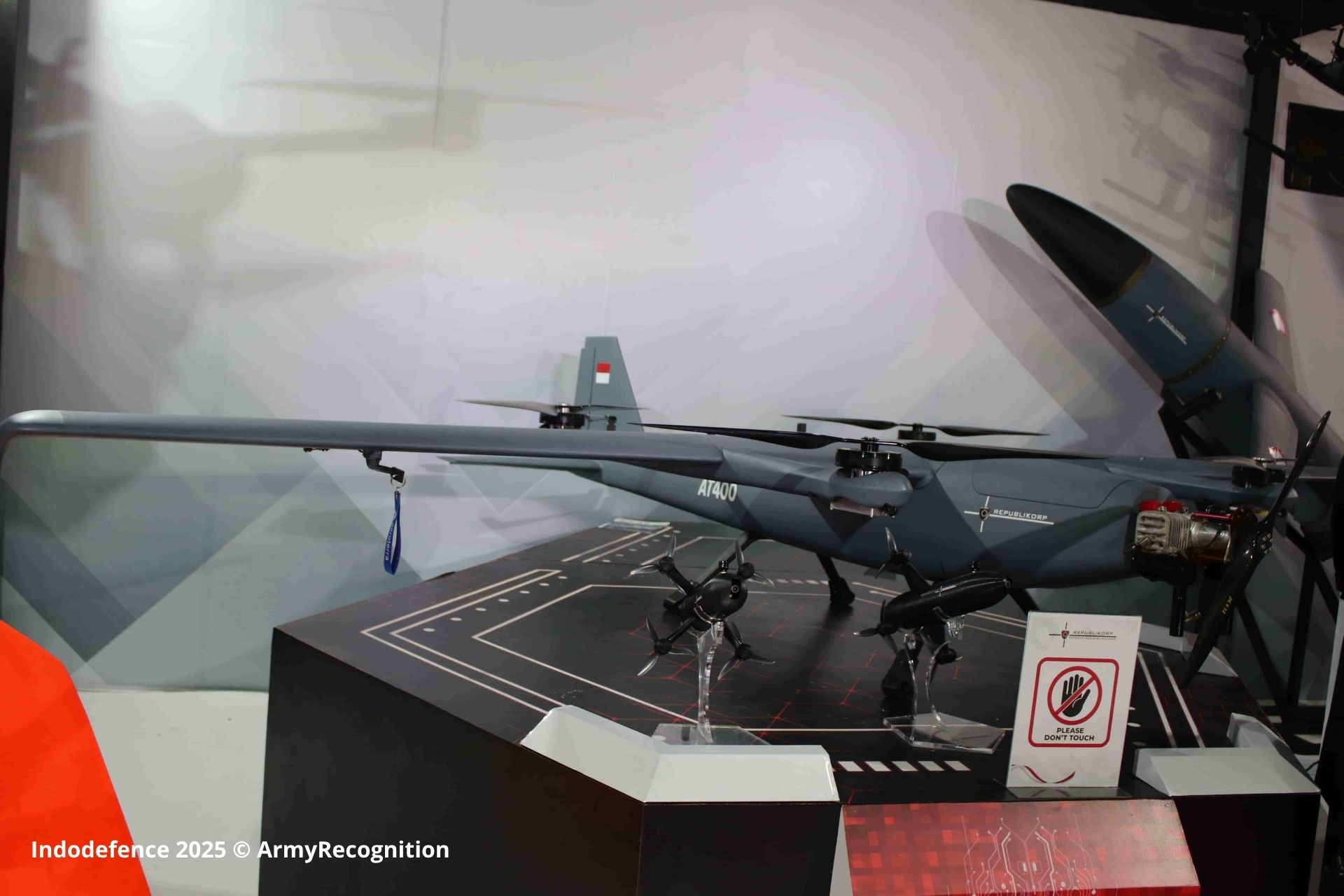Indodefence 2025: Indonesia Turns to AT400 VTOL Drone for Extended Surveillance Missions

{loadposition bannertop}
{loadposition sidebarpub}
At the international defense exhibition Indodefense 2025, the Indonesian defense industry presents for the first time its new drone system designated AT400, a platform designed for long-duration surveillance and reconnaissance missions. Developed to meet the specific needs of armed forces in terms of territorial security, the AT400 integrates several technologies aimed at enhancing operational effectiveness while maintaining a modular architecture adaptable to complex environments.Follow Army Recognition on Google News at this link
The AT400 is equipped with a suite of sensors and software tools supporting detection and identification tasks. (Picture source: Army Recognition)
The AT400 is characterized by its vertical takeoff and landing (VTOL) capability combined with a fixed-wing aerodynamic configuration, a technical choice that allows it to merge the benefits of hovering with those of stable, extended cruising. This dual capability provides notable operational flexibility for missions conducted in confined environments (such as urban areas, dense forests, or rugged terrain) as well as for long-distance patrols. The entire system is designed with a focus on endurance and reliability, with a stated flight autonomy of four hours, placing it in the category of medium-range tactical drones.
In terms of command and control, the AT400 is operated via a reinforced ground control station, suited to difficult field conditions. The drone’s operational range reaches up to 100 kilometers, offering extended coverage for surveillance, target acquisition, or area monitoring missions. Control of the system is handled by a small team of two to three operators, facilitating rapid deployment and field maintenance. This simplified operation, combined with a robust user interface, makes the system suitable for both conventional units and specialized forces or territorial security services.
The AT400 is equipped with a suite of sensors and software tools supporting detection and identification tasks. It integrates artificial intelligence dedicated to automatic target detection, capable of classifying and prioritizing objects based on predefined parameters. Its payload includes a combination of optronic equipment featuring a 30x optical zoom, a 7IR thermal camera, and a laser rangefinder (LRF), enabling both day and night observation. A picture-in-picture mode allows multiple video streams to be displayed simultaneously, improving situational awareness for the operator. The platform’s ability to locate targets and measure distance enhances its relevance for artillery support or target designation in coordinated operations.
With a maximum takeoff weight of 40 kilograms, the AT400 is relatively lightweight for its class. This manageable weight facilitates ground transport and deployment from improvised or unprepared sites. The drone’s design and propulsion system are engineered to limit both noise and thermal signature, supporting discreet use in operational environments.
The unveiling of the AT400 at Indodefense 2025 forms part of a broader strategy to promote national capabilities in defense technology. In a context where demand for autonomous ISR (Intelligence, Surveillance, Reconnaissance) systems is growing, particularly in archipelagic countries or regions facing hybrid threats, Indonesia aims to position the AT400 as a system that is both adaptable and ready for rapid operational integration.
The proliferation of this category of platform, of which the AT400 is a representative example, reflects ongoing changes in the regional strategic landscape. Medium-endurance drones are gradually becoming essential tools for sovereignty enforcement, border monitoring, and countering illicit activities at sea or in jungle environments. The ability of national manufacturers to develop complete, durable, and multi-purpose systems signals the increasing strategic autonomy of emerging defense actors. The AT400 may represent a key milestone in the export of Indonesian technologies to states seeking ISR solutions that are both cost-effective and technically credible.

{loadposition bannertop}
{loadposition sidebarpub}
At the international defense exhibition Indodefense 2025, the Indonesian defense industry presents for the first time its new drone system designated AT400, a platform designed for long-duration surveillance and reconnaissance missions. Developed to meet the specific needs of armed forces in terms of territorial security, the AT400 integrates several technologies aimed at enhancing operational effectiveness while maintaining a modular architecture adaptable to complex environments.
Follow Army Recognition on Google News at this link
The AT400 is equipped with a suite of sensors and software tools supporting detection and identification tasks. (Picture source: Army Recognition)
The AT400 is characterized by its vertical takeoff and landing (VTOL) capability combined with a fixed-wing aerodynamic configuration, a technical choice that allows it to merge the benefits of hovering with those of stable, extended cruising. This dual capability provides notable operational flexibility for missions conducted in confined environments (such as urban areas, dense forests, or rugged terrain) as well as for long-distance patrols. The entire system is designed with a focus on endurance and reliability, with a stated flight autonomy of four hours, placing it in the category of medium-range tactical drones.
In terms of command and control, the AT400 is operated via a reinforced ground control station, suited to difficult field conditions. The drone’s operational range reaches up to 100 kilometers, offering extended coverage for surveillance, target acquisition, or area monitoring missions. Control of the system is handled by a small team of two to three operators, facilitating rapid deployment and field maintenance. This simplified operation, combined with a robust user interface, makes the system suitable for both conventional units and specialized forces or territorial security services.
The AT400 is equipped with a suite of sensors and software tools supporting detection and identification tasks. It integrates artificial intelligence dedicated to automatic target detection, capable of classifying and prioritizing objects based on predefined parameters. Its payload includes a combination of optronic equipment featuring a 30x optical zoom, a 7IR thermal camera, and a laser rangefinder (LRF), enabling both day and night observation. A picture-in-picture mode allows multiple video streams to be displayed simultaneously, improving situational awareness for the operator. The platform’s ability to locate targets and measure distance enhances its relevance for artillery support or target designation in coordinated operations.
With a maximum takeoff weight of 40 kilograms, the AT400 is relatively lightweight for its class. This manageable weight facilitates ground transport and deployment from improvised or unprepared sites. The drone’s design and propulsion system are engineered to limit both noise and thermal signature, supporting discreet use in operational environments.
The unveiling of the AT400 at Indodefense 2025 forms part of a broader strategy to promote national capabilities in defense technology. In a context where demand for autonomous ISR (Intelligence, Surveillance, Reconnaissance) systems is growing, particularly in archipelagic countries or regions facing hybrid threats, Indonesia aims to position the AT400 as a system that is both adaptable and ready for rapid operational integration.
The proliferation of this category of platform, of which the AT400 is a representative example, reflects ongoing changes in the regional strategic landscape. Medium-endurance drones are gradually becoming essential tools for sovereignty enforcement, border monitoring, and countering illicit activities at sea or in jungle environments. The ability of national manufacturers to develop complete, durable, and multi-purpose systems signals the increasing strategic autonomy of emerging defense actors. The AT400 may represent a key milestone in the export of Indonesian technologies to states seeking ISR solutions that are both cost-effective and technically credible.





